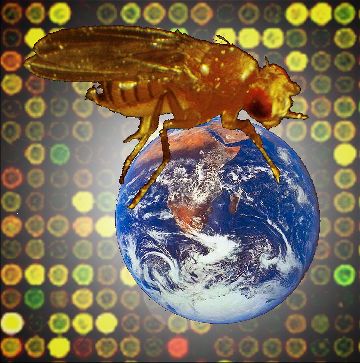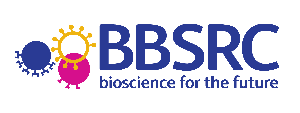
FlyAtlas: the Drosophila adult gene expression atlas


 |
FlyAtlas: the Drosophila adult gene expression atlas |
  |
This dataset was generated by Venkat Chintapalli, Jing Wang, Julian Dow and Pawel Herzyk at the University of Glasgow with funding from the UK's BBSRC, as part of its Investigating gene function initiative. It makes use of the University of Glasgow's Sir Henry Wellcome Functional Genomics Facility.
The dataset so far comprises 44 Affymetrix Dros2 expression arrays, each mapping the expression of 18770 transcripts - corresponding to the vast majority of known Drosophila genes. The dataset thus contains over 822800 separate datapoints. This website is intended to make the data easily accessible and comprehensible to mere mortals.
The starting material was wild-type Canton S adult flies, reared at 22C on a 12:12h light regime, on standard Drosophila diet, 1 week after adult emergence. We chose adults because (a) embryonic expression is already well covered elsewhere, and (b) we think that functional genomics requires analysis of function, not just of development. So if you have a gene of interest, it may be important (or just easier) to study it in adults. This website will tell you which tissues you should focus on first.
Tissues were dissected out (from equal numbers of male and female 7-day old flies except -obviously - in the case of gonads) and pooled to make at least 1500 ng mRNA, then amplified and hybridised using the Affymetrix standard protocol. For each tissue, 4 independent biological replicates were obtained. Each array thus corresponds to one biological replicate.
The tissues chosen so far are:
| Tissue |
Definition |
Number per sample |
Protocol |
| Adult Brain |
Excludes eyes and head capsule. |
|
Normal |
| Adult Head |
Severed at the neck. Includes brain, eyes, cuticle and some fat body. |
|
Normal |
| Adult Eye |
Dissected from the brain and the rest of the head capsule. So includes plenty of cuticle. |
|
Normal |
| Adult Thoracicoabdominal ganglion |
The fused thoracic ganglia that are easily dissected from the ventral surface of the thorax after removing the head. |
|
Normal |
| Adult Salivary gland |
The glands lying on the ventral lateral sides of the thorax. |
|
Normal |
| Adult Crop |
The round diverticulum of the foregut, including the stalk. |
|
Normal |
| Adult Midgut |
From (and including) the proventriculus, down to just in front of the insertion of the Malpighian tubules. |
|
Normal |
| Adult Tubule |
Both anterior and posterior tubules with their common ureters, severed at the junction with the gut. |
|
Normal |
| Adult Hindgut |
From the insertion of the tubules, back to and including the rectum. |
|
Normal |
| Adult Heart |
The Dorsal abdominal heart, necessarily including some adherent tissues (such as fat body) |
|
Normal |
| Adult Fat body |
Identifiable fat body from the thorax and abdomen. |
|
Normal |
| Adult Ovary |
Ovaries from mated females, excluding the uterus and spermatheca.††† |
|
Normal |
| Adult Testis |
Testis excluding the accessory glands. |
|
Normal |
| Adult Male accessory glands |
Accessory glands excluding other parts of the male genital tract. |
|
Normal |
| Adult Virgin spermatheca |
Spermatheca (excluding ovaries and uterus) from 7-day old virgin females kept isolated from males from adult emergence. |
|
Normal |
| Adult Mated spermatheca Spermatheca |
(excluding ovaries and uterus) from 7-day old females allowed to mate from emergence. |
|
Normal |
| Adult carcass |
Whatís left of the thorax and abdomen after the gut and sexual tracts have been removed. |
|
Normal |
| Larval CNS |
The brain and thoracic ganglia. |
|
Normal |
| Larval Salivary gland |
Salivary glands including ducts. |
|
Normal |
| Larval midgut |
From (and including) the proventriculus, down to just in front of the insertion of the Malpighian tubules. |
|
Normal |
| Larval tubule |
Both anterior and posterior tubules with their common ureters, severed at the junction with the gut. |
|
Normal |
| Larval hindgut |
From the insertion of the tubules, back to and including the rectum. |
|
Normal |
| Larval fat body |
Prominent lateral fat bodies. |
|
Normal |
| Larval trachea |
The major tracheal trunks, excluding spiracles and obvious adherent tissues. |
|
Normal |
| Larval carcass†††† |
Whatís left after the other tissues have been removed. |
|
Normal |
| S2 cells (growing) |
Invitrogen S2 cells growing at 25C in Schneiderís medium, before confluence. |
|
Normal |
| Whole fly |
I think you can guess this one. |
|
Normal |
For this table, “Adult” means 7-day old Canton S wild-type flies,
grown on standard Drosophila diet at around 50 flies per vial at 23C on a 12:12
h photoperiod. Unless it’s obviously a sex-specific tissue, equal numbers
of males and females were used for each dissection. “Larval” means
third instar feeding larvae (i.e. the kind you have to dig out of the food,
not wandering (prepupal) larvae. They were raised under the same conditions.
(*small-sample array protocols are used when starting material is really limiting. We use 100 ng total RNA in the Affymetrix Small-sample protocol II. As with all of life, you get "nowt for nowt"; the noise will be higher in these samples, but at least there IS data.)
We also have larval tissues (from mixed sex, wandering third instar larvae)
This means you can deduce at least 3 things from the results;
The paper now describing this work
is now published:
Chintapalli,
V. R., Wang, J., and Dow, J. A. T. (2007). Using FlyAtlas to identify better
Drosophila models of human disease. Nature Genetics 39:
715-720
We would be most grateful if you would cite this paper. If you send us details of your publication, we'll start a bibliography page!
We checked a number of genes with known specificity. So for example, the visual transduction channel gene trp has a signal of 2649 in head, but only 74 in brain, confirming that the brains were cleanly dissected. Conversely, the potassium channel Shaker had a signal of 676 in brain but a signal below 30 in head and all other tissues studied. Of course, such analyses can lead to some real 'gems': genes that are fantastically enriched in individual tissues. On separate webpages, we give our 'top 50' enriched genes for each tissue in the atlas. Enjoy!
To contact us, please email Julian Dow.
The data are as consistent as the SEMs on each sample. Generally, the samples are pretty tight, because (i) each sample is necessarily pooled from many animals, (ii) we use 4 replicates, which is really the minimum for an array experiment, and (iii) the Affymetrix platform is the gold standard for consistency.
The data are highly quantitative for any particular gene. You shouldn't really compare between genes; so rather than say "gene X is 20% more abundant than gene Y because its signal is 1200 compared with 1000", you should say "genes X & Y are both among the most abundant transcripts in this tissue". However, to a first approximation, the signals reported by the Affy array do correlate closely with qPCR data: see Fig. 2 of our array paper for an example with 12 genes with very different abundance.
In our experience, the data are highly trustworthy. We've now worked up at least 50 genes, and not found a single one that does not stand up to qPCR validation. You're more likely to have issues with whether the probeset really matches your gene of interest, for example. Nonetheless, if I were refereeing your grant proposal, I think I'd expect to see qPCR validation of these data before you embarked on a huge research project.
Of course: they're in the public domain. But we'd appreciate the courtesy of a citation, as mentioned above.
Some genes span a large region of the genome, and have multiple transcripts. Although it isn't a true exon array, such genes may have several probesets assigned to them, perhaps because the probesets were designed before it was realised that the exons were part of a single gene.
You should see this as an opportunity, rather than a threat, because it may give you transcript-specific information. (For example, there are separate probesets for the male and female-specific transcripts of doublesex.)
To help you with this, I've hyperlinked the probeset data; so if you click on the affy reference (e.g. 1234567_at), you can see the DNA sequences of the 14 probes for that gene. I've even included a link to an automated BLASTN search against Drosophila reference transcripts, so you can see which ones it recognises.
This is a 'feature' of the search engine. It searches for a literal string, anywhere it may be found. (For technical reasons, the workaround for CG numbers is to put a dash at the end of the number, e.g. "CG1234-".) This means that you can search with word stems: for example "mitochon" will give you "mitochondria", "mitochondrial", and "mitochondrion". Or "Acp" will give you all the male accessory protein genes, as well as a few off-target ones.
Actually, I'm a believer in serendipity; sometimes, these off-target hits can be really interesting, so I don't mind running my eye over them.
It has no formal significance; it's just intended to draw your eye to tissues where the enrichment relative to whole fly is over 5 (i.e. really interesting by any standards).
I'm seeing a really high SEM on gene x in tissue y.
Proceed with caution! This may reflect an individual array outlier, or genuine biological variability, or perhaps inclusion of a different tissue in one of the samples. Helen White-Cooper has noticed that some testis-specific genes have significant signals in larval fat body, suggesting that one of the samples may have included some larval gonad (we plan to repeat some arrays for this tissue). However, this is the only case of possible contamination of which we are aware. As with all our dataset, it's advisable to go in and check with qPCR before committing your whole lab to working on a surprising hit.
Why the larval tissues?
i) Larvae are no less interesting than embryos or adults. ii) We have applied for money that would, if granted, allow us to do something similarly comprehensive for other life stages. iii) Meanwhile, comparison of adult v larval tubule provides an estimate of the number of differences we might see in the same tissue between different life stages (several hundred). iv) We aren't able to dissect adult fat body to our standards. So we're providing larval fat body in the interim. You'll see that larval fat body resembles head for many genes, because most of the fat body in adults resides in the head capsule.
Or you can search Google Scholar for the early-adopters who've already got papers out using it!
This is "gradstudentware" - please send us your promising graduate students. Seminar invitations near ski areas (in season) are also welcome.